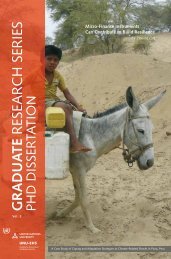Unveiling Women as Pillars of Peace Peace Building in ...
Unveiling Women as Pillars of Peace Peace Building in ...
Unveiling Women as Pillars of Peace Peace Building in ...
You also want an ePaper? Increase the reach of your titles
YUMPU automatically turns print PDFs into web optimized ePapers that Google loves.
Once raided, animals are driven across borders and sold to markets beyond the reach <strong>of</strong><br />
p<strong>as</strong>toralists. In this situation, traditional rescue efforts and negotiation mechanisms are useless.<br />
Raid<strong>in</strong>g h<strong>as</strong> become an <strong>in</strong>come generat<strong>in</strong>g activity rather than a means for augment<strong>in</strong>g social status<br />
or fulfill<strong>in</strong>g cultural roles. Know<strong>in</strong>g that raided cattle are valuable commercial <strong>as</strong>sets <strong>in</strong> a money<br />
economy and that raided animals may never be recovered, p<strong>as</strong>toralists are forced to guard their<br />
rema<strong>in</strong><strong>in</strong>g stock closely. Attempts at raid<strong>in</strong>g are met with strong resistance, <strong>of</strong>ten end<strong>in</strong>g <strong>in</strong><br />
m<strong>as</strong>sive destruction <strong>of</strong> property and loss <strong>of</strong> life.<br />
An <strong>in</strong>cre<strong>as</strong><strong>in</strong>g <strong>in</strong>flux <strong>of</strong> arms complicates the pressures from the environment and the<br />
expansion <strong>of</strong> animal export commerce. Follow<strong>in</strong>g the concert <strong>of</strong> conflicts <strong>in</strong> the Horn <strong>of</strong> Africa,<br />
and north-e<strong>as</strong>tern Uganda, all <strong>of</strong> northern Kenya h<strong>as</strong> become an arms bazaar. Two developments<br />
have <strong>in</strong>cre<strong>as</strong>ed the quantity and quality <strong>of</strong> arms. First, the <strong>in</strong>flux <strong>of</strong> <strong>as</strong>ylum seekers from countries<br />
afflicted by conflict h<strong>as</strong> overwhelmed the capacity <strong>of</strong> the Kenyan government to control the guns<br />
that come <strong>in</strong> with these populations. Combatants, <strong>in</strong>clud<strong>in</strong>g militi<strong>as</strong>, mercenaries, and remnants <strong>of</strong><br />
armies from countries at war, have come with these groups. These men br<strong>in</strong>g the skills and<br />
knowledge <strong>of</strong> wag<strong>in</strong>g war along with their sophisticated weapons. The <strong>in</strong>flux <strong>of</strong> all these armed<br />
groups means that the p<strong>as</strong>toralists have to contend with more than the traditional raiders. Fight<strong>in</strong>g<br />
groups operat<strong>in</strong>g from northern Kenya <strong>in</strong>clude the Oromo Liberation Front (OLF) who are fight<strong>in</strong>g<br />
a low-key secessionist war <strong>in</strong> Ethiopia, the Sudan Peoples Liberation Army (SPLA), and<br />
miscellaneous other groups support<strong>in</strong>g Somali warlords. This situation h<strong>as</strong> ignited an arms race<br />
throughout the region. Incre<strong>as</strong>ed violence and <strong>in</strong>security have followed.<br />
Conflicts Between P<strong>as</strong>toral and Agricultural Communities<br />
Faced with expand<strong>in</strong>g desertification from the north, ecological pressure with<strong>in</strong> their zones, and<br />
encroachment on the fr<strong>in</strong>ges <strong>of</strong> their lands by farm<strong>in</strong>g communities, p<strong>as</strong>toralists have responded <strong>in</strong><br />
ways that have escalated ethnic conflicts.<br />
Many p<strong>as</strong>toralists have moved out <strong>of</strong> their regions <strong>in</strong> search <strong>of</strong> p<strong>as</strong>tures for their<br />
significantly reduced herds or alternative means <strong>of</strong> subsistence. This development h<strong>as</strong> brought<br />
them <strong>in</strong>to direct conflict with non-p<strong>as</strong>toral communities. Migrat<strong>in</strong>g groups come <strong>in</strong>to conflict with<br />
agricultural communities liv<strong>in</strong>g on the borderlands <strong>of</strong> semiarid and arable lands. For example,<br />
conflicts between the Somalis and the Akamba people <strong>of</strong> northern Mw<strong>in</strong>gi District, or between<br />
communities <strong>in</strong> northern Meru, epitomise the cl<strong>as</strong>h <strong>of</strong> different ways <strong>of</strong> life and the failure <strong>of</strong> a<br />
harmonious <strong>in</strong>terface between p<strong>as</strong>toral and agricultural modes <strong>of</strong> production.<br />
For those without animals, the search for other means is affected by lack <strong>of</strong> education,<br />
skills, or tra<strong>in</strong><strong>in</strong>g. The p<strong>as</strong>toral communities have the lowest levels <strong>of</strong> education and tra<strong>in</strong><strong>in</strong>g.<br />
Therefore, those who seek jobs, enter the labour market at the lowest stratum. Some end up <strong>as</strong><br />
farm hands <strong>in</strong> agricultural are<strong>as</strong>, <strong>of</strong>ten be<strong>in</strong>g paid <strong>as</strong> little <strong>as</strong> the food they need for survival.<br />
Others have moved to cities. In both c<strong>as</strong>es, they jo<strong>in</strong> the <strong>in</strong>habitants <strong>of</strong> sprawl<strong>in</strong>g slums <strong>in</strong> towns<br />
and peri-urban are<strong>as</strong>. Private security companies favour the Turkana and Ma<strong>as</strong>ai because <strong>of</strong> their<br />
reputation for fearlessness. They can obta<strong>in</strong> employment <strong>as</strong> watchmen, a job that is not only among<br />
the lowest paid, but also carries great risks (Kitunyi 1991). Just <strong>as</strong> their counterparts <strong>in</strong> the<br />
agricultural sector, they are exploited and abused.<br />
Movement out <strong>of</strong> the northern p<strong>as</strong>toral zone ultimately destroys p<strong>as</strong>toral communities and<br />
their way <strong>of</strong> life. It h<strong>as</strong> resulted <strong>in</strong> family breakdown <strong>as</strong> the ma<strong>in</strong>ly male population gravitates to<br />
urban centres and agricultural are<strong>as</strong>. Left without any other livelihood, the dependency on relief<br />
<strong>as</strong>sistance h<strong>as</strong> become the other “mode <strong>of</strong> subsistence” for those left beh<strong>in</strong>d. Most <strong>of</strong> these people<br />
are unprotected women and children who make e<strong>as</strong>y targets for raiders. In Turkana for example, it<br />
11



